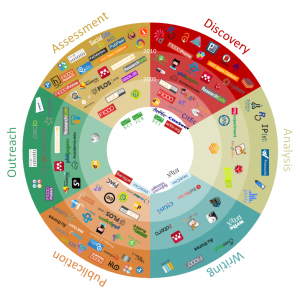
The scholarly ecosystem gets more complicated every day. As this graphic depicts- click for larger size – there are new tools being used by researchers every day to discover, access, and use scholarly research.
Until the Open Access movement gains ground, most researchers are beholden to content providers, services, and academic libraries for their access to scholarly research in e-content form. And that access could be better!
Roger Schonfeld writes of the stumbling blocks to this access in Dismantling the Stumbling Blocks that Impeded Researchers’ Access to e-Resources:
To adapt, publishers, libraries, and intermediaries need to examine not only the usability of their own platforms and how they can continue to be improved, but also how they are in practice used in scholarly research alongside other platforms and services. To do so, they cannot bring researchers into their usability labs, but instead they must engage researchers in their workplaces, in campus offices, labs, libraries, and dorms, and equally in off-campus homes and housing.
At the main information desks of research libraries, desktop workstations are used to test access and services to e-resources; while our researchers are living in a multi-device digital world of mobile, laptop, and tablet access. We will be examining parts of this scholarly ecosystem in the coming months and its impact on our users.
Tools to use: Today, ProQuest (content provider) announced a partnership with Google Scholar to provide journal and conference connections through Google Scholar. The University of Pittsburgh University Library System provides this helpful Scholarly Communications glossary; and the graphic above is from the 101 Innovations in Scholarly Communications project and begins to congregate the new tools and workflows our researchers are using.
